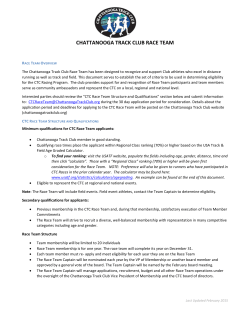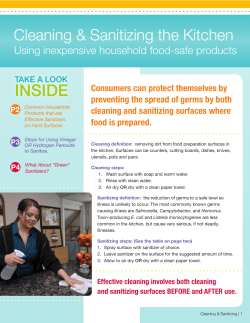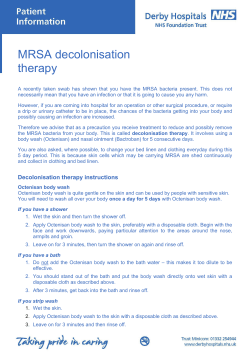
18 Water, sanitation and hygiene (WASH) in cholera treatment centres in emergencies
18 TECHNICAL NOTES ON DRINKING-WATER, SANITATION AND HYGIENE IN EMERGENCIES Water, sanitation and hygiene (WASH) in cholera treatment centres in emergencies Cholera Treatment Centres (CTCs) or smaller Cholera Treatment Units (CTUs) may be established during outbreaks of cholera or other severe diarrhoeal diseases to isolate and treat patients and help control the spread of disease. CTCs and CTUs are environments with a high concentration of pathogens and a full range of WASH interventions is required to limit the spread the spread of disease within the facility and to the surrounding environment. The importance of WASH in CTCs and CTUs During outbreaks of cholera, or other diarrhoeal diseases, health-care facilities may quickly become overcrowded and insanitary as a result of rises in patients. A quick response is required to strengthen standards of WASH in order to protect staff, carers, and patients, and to avoid contaminating communities around the facility. General principles The following principles are based on the WHO publication WASH in health-care facilities in emergencies (2012). All the interventions should be carried out to an acceptable standard so infection routes in the health-care setting are blocked. Organise space and activities, and control movement. The layout of the CTC should be planned around the pathway taken by the patient through the facility. Movement between each section in the CTC should be controlled to reduce the spread of contamination. The main strategies for restricting movement include: Providing drinking-water, handwashing points, toilets and showers in each section. Providing clear information, with repeated explanation to all new patients and carers. Posting guards at key locations, particularly the entrances, exits and central passage between the sections. Manage entrances and exits. Ensure that entrances and exits to the CTC have functional foot baths or chlorine solution sprayers, handwashing stations and permanent guards. This may involve providing basic equipment (chlorinated handwashing stations, soap, backpack sprayers, chlorine, buckets, mixing spoons, bowls) and training guards to limit the number of people entering the area in addition to ensuring anyone entering or leaving disinfects their feet and washes their hands with soap. Establish a dedicated CTC with its own WASH services. During outbreaks of highly infectious diseases, it is recommended that patients are managed in CTCs and CTUs. These isolated centres should ideally be located away from the rest of the rest of the health-care facility. Ensure that CTCs or CTUs are fully fenced and have their own dedicated, functional and safe toilets, showers, laundry, changing area, and health-care waste disposal facilities. TECHNICAL NOTES ON DRINKING-WATER, SANITATION AND HYGIENE IN EMERGENCIES 18.1 WASH in cholera treatment centres in emergencies Ensure all water supplies are chlorinated regardless of use. All water supplies during times or risk of diarrhoeal disease epidemics must be chlorinated so there is a free chlorine residual level of at least 1.0 mg/l at the point of consumption. This is higher than normal and provides additional protection in a contaminated environment. For effective chlorination, the turbidity should be less than 5NTU. Residual free chlorine levels should be checked daily with a colour comparator (e.g. pool tester) and it may be necessary to re-chlorinate if levels drop during storage. It may also be necessary to re-chlorinate municipal (piped) water supplies if they are not adequately chlorinated. out using simple equipment, such as a drum of water equipped with a tap, a basin for wastewater and soap. Wastewater should be collected and disposed of in a soakaway that does not contaminate the groundwater. If available, healthcare workers may use an alcohol-based hand-rub instead of soap to routinely clean their hands between patient contacts, if hands are not visibly dirty. Provide sufficient quantities of safe water. A large quantity of water is required in a CTC, for handwashing, cleaning, disinfecting, bathing and laundering. In most cases, plan for 60 litres per patient per day and 15 litres per carer per day. It is very important there is never a shortage of water. Ensuring there is sufficient water may require interventions to repair the water supply (or power or fuel supply if the water system requires power or fuel to function), install basic emergency water treatment units, or organise water tankering. It may also involve the installation of temporary water storage facilities such as demountable steel water tanks, bladder tanks or polyethylene tanks. There should be at least three days quantity of water stored in a closed tank in case of a break in supply. Handwashing facilities. Handwashing with soap and chlorinated water (see table 18.1 below) is an effective barrier to cholera transmission. Ensure that there are sufficient numbers of functional handwashing facilities with chlorinated water, soap and safe wastewater disposal next to toilets and at every entrance and exit. Handwashing may be carried Hygiene promotion. Ensure that hygiene educator inform patients, and carers of essential hygiene behaviours repeatedly, starting within 30 minutes of arrival and then continuously throughout their visit. Staff, patients and carers should be reminded to wash their hands at these critical times: When entering/leaving the CTC. Before preparing food. Before eating. After going to the toilet. After cholera patient contact. After handling stools and vomit. After cleaning and disinfecting contaminated surfaces/objects. TECHNICAL NOTES ON DRINKING-WATER, SANITATION AND HYGIENE IN EMERGENCIES Containment and disposal of excreta. An average of 1 toilet per 20 people should be provided separated for men and women with separate toilets for staff. All toilets should be regularly cleaned and disinfected. Wastes from patients with uncontrollable diarrhoea and vomiting should be collected in graduated basins under the bed (to be monitored by medical staff). These recipients should be emptied and rinsed regularly with half a cup of 2% chlorine solution added before reuse. The waste should be disposed of in a specific toilet used only for this purpose. All latrines and waste pits must be located at least 10m downhill of water sources and so there is at least 2m between the bottom of the pit and highest seasonal groundwater level. If this is not possible seek specialist advice. If the facility uses septic tanks, check that the effluent does not contaminate groundwater or flow out of the facility. If septic tanks are emptied, ensure that the sludge is handled and disposed of safely. Seek specialist advice on this. 18.2 WASH in cholera treatment centres in emergencies Cleaning and disinfecting. Regular cleaning and disinfection of contaminated surfaces and objects in the CTC is an essential barrier to the spread of contamination. Ensure that the CTC has separate cleaning equipment (detergent, mops, buckets, sprayers, chlorine) for each section. Consider installing plastic sheeting to facilitate cleaning in temporary facilities. Table 18.1 shows the chlorine solutions used for disinfection and the quantities of chlorine products to make them. The procedures for cleaning and disinfection in the CTC are as follows: Floors: mop with 0.2% chlorine solution twice per day. Beds: wipe with 0.2% chlorine solution daily and between patients. Spills of stools and vomit: mop up and disinfect with 2% chlorine solution. Clothes and sheets: soak in 0.2% chlorine solution for 10 minutes then rinse, wash as normal and dry on a line. Cooking and eating utensils: rinse in 0.05% chlorine solution then wash and dry on racks. Shoes and feet: disinfect by spraying or walking through a footbath containing 0.2% chlorine solution when moving between sections or when entering and leaving the CTC. Change footbaths twice a day as chlorine loses its disinfection properties in muddy water. Hands: wash with soap and chlorinated water or spray with 0.05% chlorine solution on entering and leaving the CTC. Dead bodies: wash with 2% chlorine solution, and block orifices with cotton wool soaked in the same solution. CTC Health-care waste management. Ensure that all infectious wastes, sharps, excreta and body fluids created in the isolation area are disinfected with 2% chlorine solution and disposed safely within the isolation area. Ensure safe segregation, collection, transport, treatment and disposal of all CTC health-care waste. Consider providing sufficient numbers of durable and safe colour-coded containers in all parts of the CTC where healthcare wastes are generated, creating a dedicated waste disposal zone within the CTC, and ensuring staff have appropriate personal protective equipment and are trained in waste management. Train guards to ensure that no material acting as a potential cholera pathogenic reservoir is carried out of the CTC e.g. food, food containers, or soiled clothing. Table 18.1 Preparation of 2%, 0.2%, and 0.05% chlorine solutions Use the following table to calculate the quantity of various chlorine generating products required to prepare the three main disinfecting solutions for a Cholera Treatment Centre or Cholera Treatment Unit. Solution ‘A’ 2% Chlorine Solution ‘B’ 0.2% Chlorine Solution ‘C’ 0.05% Chlorine (Use to disinfect vomit, feaces, corpses) (Use to disinfect floors, walls, beds, feet, clothes) (Use for handwashing and disinfecting eating utensils) Calcium hypochlorite (HTH) at 70% active chlorine 30g per litre (2 level dessert spoons per litre) 3g per litre (2 level dessert spoons per 10 litres) 0.7g per litre (1/2 level dessert spoon per 10 litres) Chlorinate lime at 30% active chlorine 60g per litre (4 level dessert spoons per litre) 6g per litre (4 level dessert spoons per 10 litres) 1.4g per litre (1 level dessert spoon per 10 litres) 20 tablets per litre 2 tablets per litre 5 tablets per 10 litres 166ml per litre 16ml per litre 4ml per litre 500ml per litre 50ml per litre 12ml per litre NaDCC Tablets at 1g active chlorine per tablet Sodium hypochlorite concentrate at 15% active chlorine Sodium hypochlorite (bleach) at 5% active chlorine TECHNICAL NOTES ON DRINKING-WATER, SANITATION AND HYGIENE IN EMERGENCIES 18.3 WASH in cholera treatment centres in emergencies Personal Protective Equipment (PPE). Personal protective equipment should be provided to all staff who may be exposed to contamination in the CTC. Medical staff should have the correct PPE for their activities. WASH staff carrying out specific tasks such as cleaning or health-care waste management should also have appropriate PPE such as gloves, masks, overalls and boots. Overcrowding. CTCs may quickly become overcrowded due to an unanticipated rise in admission. Ensure that wards are not overcrowded and there is at least 1-2m between beds to reduce transmission risks. Ensure that there is a maximum of one carer per patient. Work with the facility to identify and establish new locations for temporary CTC overflow such as car parks, courtyards, or spare wards. Wastewater disposal. Wastewater from handwashing, laundry, cooking and cleaning should be disposed in soakaway pits. It may be easier to build small soakaway pits to serve individual points. Contaminated wastewater should not be allowed to mix with rainwater and run-off and should not be allowed to flow out of the CTC. If working in or next to an existing health facility, the wastewater disposal system may be used if it is functioning correctly. Rainfall and run-off. The CTC should not be located in an area that is exposed to flooding. A drainage channel should be dug around the upper edge of the site to divert rainwater away from the site and provide extra protection. Ensure that rainwater is prevented from entering any areas of the CTC, and does not carry potentially infectious material away from the CTC into the rest of the health-care facility or the community. Disease vector control. Flies, mosquitoes and rats may become a nuisance to patients and staff, and a source of infection in the CTC, and should be carefully controlled. Various species of mosquito favour the shady and humid conditions often found in cholera-treatment wards and cholera patients are vulnerable to infection by malaria, dengue fever and other mosquito-borne diseases. If there are problems with disease vectors seek specialist advice. Food safety. In some cases, food may be prepared at the healthcare facility. In all cases, it is essential that all food that is stored, prepared, and consumed by patients, staff and carers is safe. Ensure proper handwashing, food handling is carried out with utmost cleanliness, food is thoroughly cooked, and safe water is used in food preparation. Human resources. Managing WASH in a CTC is a very intensive activity, requiring a number of specialist roles and overall supervision. The following posts need to be permanently (24 hours) filled in a typical CTC: 1 x WASH supervisor / officer 3 x Cleaners 2 x Laundry workers 6 x Sprayers / guards 2 x Water carriers 1 x Chlorine-solution makers 1 x Waste technician 1 x Hygiene promoter Recruitment and training needs to be organised very quickly at the start of an outbreak, and refresher training is important, to develop skills and improve the quality of work. Further information WHO (2012) WASH in health-care facilities in emergencies. World Health Organization, Geneva. MSF (2004). Cholera Guidelines. Second Edition. Médecins Sans Frontières, Paris. WHO (2004). Standard precautions in health-care: aide memoire. World Health Organization, Geneva. Water, Sanitation, Hygiene and Health Unit Avenue Appia 20 1211 Geneva 27 Switzerland WHO (2004). Cholera outbreak: assessing the outbreak response and improving preparedness. World Health Organization, Geneva. ACF (2005). Water, sanitation and hygiene for populations at risk. Action Contre la Faim, Paris. Telephone: Telephone (direct): Fax (direct): Email Coordinator: URL: +41 22 791 2111 +41 22 791 3555/3590 +41 22 791 4159 bosr@who.int www.who.int/water_sanitation_health Prepared for WHO by Ben Harvey Editorial contributions by John Adams, Dominique Maison, and Jean McCluskey Line illustrations by Chandan Dhoj Rana Magar © World Health Organization 2012 All rights reserved. All reasonable precautions have been taken by the World Health Organization to verify the information contai ned in this publication. However, the published material is being distributed without warranty of any kind, either expressed or implied. The responsibility for the interpretation and use of the material lies with the reader. In no event shall the World Health Organization be liable for damages arising from its use. 18.4
© Copyright 2025





















